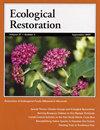Early Impacts of Invasive Shrub Removal on Riparian Arthropod Communities
IF 1.1
4区 环境科学与生态学
Q2 ECOLOGY
引用次数: 0
Abstract
ABSTRACT Plant invasions can change native communities in complex ways. Restoring invasion-altered habitats starts with invader removal, and imposes significant physical and compositional changes. Restoration facilitates desirable plant community development, but arthropod community responses to removal and the timelines required for native vegetation establishment are difficult to predict. We examined initial effects of Elaeagnus angustifolia (Russian olive) removal on arthropod communities during a long-term experiment evaluating the combined consequences of invasive shrub removal and plant community restoration. We sampled E. angustifolia-invaded areas pre-removal (2010) and post-removal (2013) using sweep netting, and identified arthropods to family level. We found greater variation in the arthropod community composition within removal blocks than within invaded blocks after two years. These shifts resulted from changes in the relative abundance of community members (e.g., Dictynidae (Araneae), Culicidae (Diptera), and Cicadellidae (Hemiptera)), rather than overall richness or diversity. This response is likely due to increased plant diversity in E. angustifolia removal sites but also structural differences in vegetation cover after removal. Removing a dominant structural element like E. angustifolia instantly changes the successional stage of the ecosystem. Thus, restoration managers should consider methods that maintain structural continuity during restoration implementation. Arthropods provide important ecosystem services such as nutrient cycling and pollination and serve as a prey base for higher trophic levels. Thus, understanding how arthropod communities change after plant restoration events is vital to assessing future management decisions to limit ecosystem impacts of invasive plants and their management.移除入侵灌木对河岸节肢动物群落的早期影响
摘要 植物入侵会以复杂的方式改变本地群落。恢复被入侵改变的栖息地首先要清除入侵者,这将带来巨大的物理和成分变化。恢复有利于理想植物群落的发展,但节肢动物群落对移除的反应以及原生植被建立所需的时间很难预测。我们在一项长期实验中考察了移除俄罗斯橄榄(Elaeagnus angustifolia)对节肢动物群落的初步影响,该实验评估了移除入侵灌木和植物群落恢复的综合后果。我们在移除前(2010 年)和移除后(2013 年)对俄罗斯榄属植物入侵区域进行了取样,并对节肢动物进行了科级鉴定。我们发现,两年后,移除区块内节肢动物群落组成的变化大于入侵区块内的变化。这些变化源于群落成员(如鹤形目(Dictynidae)、双翅目(Culicidae)和半翅目(Cicadellidae))相对丰度的变化,而非总体丰富度或多样性的变化。这种反应可能是由于移除 E. angustifolia 的地点植物多样性增加,但也可能是由于移除后植被覆盖的结构差异。移除像 E. angustifolia 这样的主要结构元素会立即改变生态系统的演替阶段。因此,恢复管理者应考虑在实施恢复过程中保持结构连续性的方法。节肢动物提供重要的生态系统服务,如养分循环和授粉,并为更高营养级提供猎物。因此,了解节肢动物群落在植物恢复活动后如何变化,对于评估未来的管理决策以限制入侵植物及其管理对生态系统的影响至关重要。
本文章由计算机程序翻译,如有差异,请以英文原文为准。
求助全文
约1分钟内获得全文
求助全文
来源期刊

Ecological Restoration
Environmental Science-Nature and Landscape Conservation
CiteScore
1.70
自引率
12.50%
发文量
24
期刊介绍:
Ecological Restoration is a forum for people advancing the science and practice of restoration ecology. It features the technical and biological aspects of restoring landscapes, as well as collaborations between restorationists and the design professions, land-use policy, the role of education, and more. This quarterly publication includes peer-reviewed science articles, perspectives and notes, book reviews, abstracts of restoration ecology progress published elsewhere, and announcements of scientific and professional meetings.
 求助内容:
求助内容: 应助结果提醒方式:
应助结果提醒方式:


